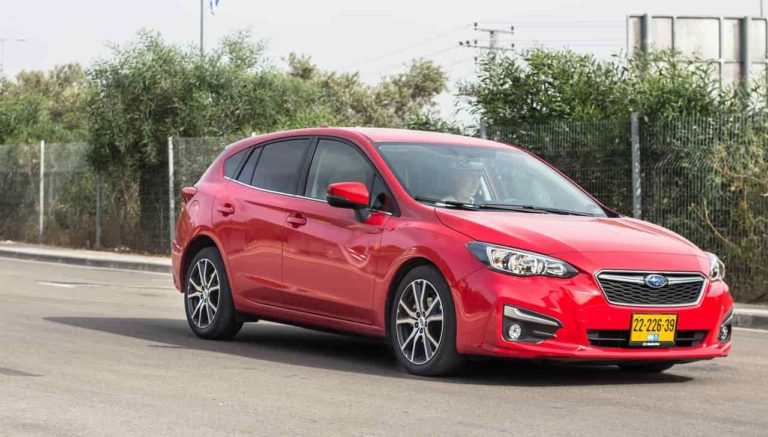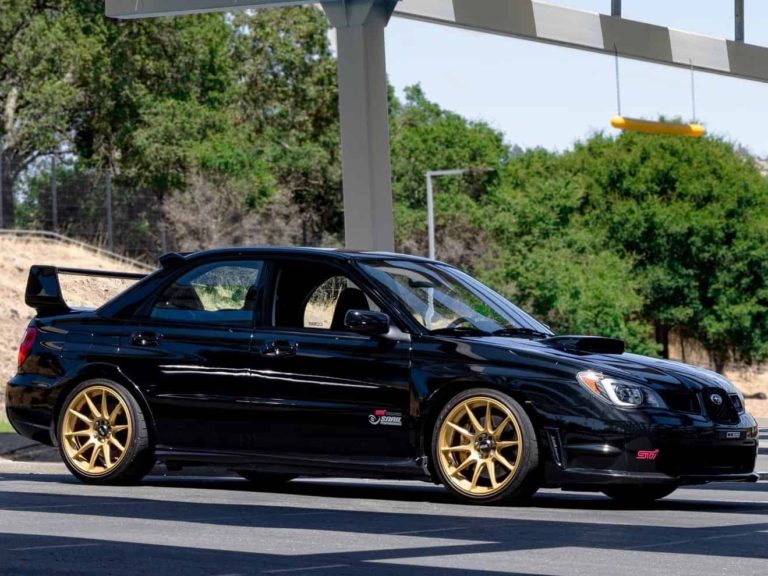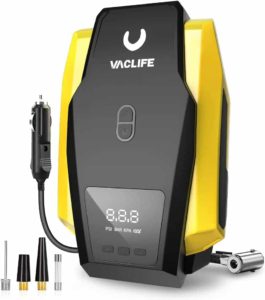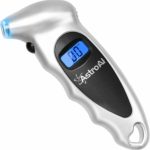What is Subaru Impreza's TPMS?
The tire pressure monitoring system (TPMS) in your Subaru Impreza is an essential safety feature designed to alert you when the tire pressure is too low. This system actively monitors the air pressure inside your tires and illuminates a warning light on your dashboard if any tire falls below the safe pressure threshold. It’s your vehicle’s way of ensuring optimal tire performance, helping maintain safety, fuel efficiency, and prolonging the life of your tires. To check your current tire pressure: Find the 3 buttons “i/Set” with the up and down arrow on the bottom left of your steering wheel. Use the top or bottom arrow to scroll through the list of screens until you see the tire pressure screen.
Important Note:
Your Subaru Impreza doesn’t come with a button to turn off the tire pressure light. This article is a guide on how the tire pressure system functions and gives you an easy 9-step method to switch off the tire light.
2023 Subaru Impreza Tire Pressure
TIRE SIZE | FRONT PSI | REAR PSI |
205/50R17 | 33 | 32 |
205/55R16 | 33 | 32 |
225/40R18 | 33 | 32 |
SPARE TIRE | 60 | 60 |
Steps To Reset Subaru Impreza Tire Pressure Light
The Subaru Impreza does not have a tire pressure reset button.
When the tire pressure light on your dashboard turns on, pull over slowly and check your tire pressure right away.
Figure out which tire is low or high on air and adjust the tire pressure accordingly. (The TPMS lets you know which tire is low on your screen by displaying the low pressure value in yellow instead of white)
Fill your tires to the exact recommended pressures. I cannot emphasize this enough, accuracy is key. 33 Psi in the front, 32 Psi in the rear tires.
Drive your Subaru Impreza. Drive for 10 or 15 minutes at speeds over 25 Mph.
If the light doesn’t go off right away, re-check your tire pressure to make sure they are all at the exact pressure you set them to. If they are down in pressure, you probably have some sort of tire leak.
If the pressures are at the exact pressure you set them to and the tire light still won’t go off, over fill your tires.
We recommend filling your problem tire with 45 Psi or about 10 Psi over the recommended pressure. With the tire overfilled, drive the car again for another 15 minutes. This will turn off the tire light.
Now that the tire light is off, readjust the pressure back to the recommended air pressures.
One more option, if you followed all these steps and the light is still on (and you don’t have a leak), check your spare tire. Some Subaru’s (depending on the package you have) do have a full size spare with a pressure sensor in them. Make sure your spare tire has 60 Psi. Now drive the car again.
NOTE: If you’ve completed all of these steps and the tire light STILL won’t go out, There is only one of three things that can be the problem. Either have a faulty tire pressure sensor in one of your wheels OR you have a leak OR your receiver module (control unit) is not communicating with your sensors (this is the least of all likely and is rare).
How Does the Subaru Impreza TPMS Work?
The Tire Pressure Monitoring System (TPMS) in a Subaru Impreza works through a combination of sensors, radio transmissions, and in-car computing to maintain safety and fuel efficiency. Here is a more in-depth explanation:
Wheel Sensors: These are the key parts of the TPMS and they’re installed inside the wheel. They’re directly attached to the wheel rim, on the end of the valve stem where you inflate the tire. The sensors measure the air pressure in the tire using a pressure transducer. The transducer converts the physical force of the air pressure into an electrical signal that can be measured. In addition to the air pressure, they also measure the temperature within the tire as significant heat changes can affect tire pressure. It’s also important to know that the sensor’s batteries are not replaceable or serviceable. When they die, the whole sensor needs to be replaced.
Radio Transmission: The sensors send data via radio frequency (RF) transmissions. The RF transmitter within the sensor sends a unique identifier for each sensor along with the tire pressure (and temperature) data. This identifier (basically an ID number) ensures that the TPMS control unit can distinguish between the four (or more) sensors in the vehicle.
TPMS Control Unit: This is the brain of the system. It’s a small electronic module, usually located under the dashboard or in the engine compartment. It has an RF receiver to pick up the transmissions from each sensor. Once it receives the data, it decodes it using the unique identifier from each sensor. Then, it compares the pressure data against Subaru’s recommended tire pressure levels.
Dashboard Warning Light: The warning light is the most visible part of the system. If the pressure in any tire is anywhere from 15%-25% or more below the manufacturer’s recommended level, the control unit will light up the TPMS warning indicator on the dashboard. This light is universal and looks like a yellow exclamation point. The Subaru Impreza also shows live current tire pressure of each tire.
Continuous Monitoring & Self-Check: The TPMS doesn’t just check the pressure at start-up. It continually monitors pressure while you’re driving. If you’re driving and a tire starts to lose pressure, the TPMS will trigger the warning light. Similarly, it will turn off the warning light if the tire pressure returns to a safe level. The system performs a self-check every time you turn on the ignition. If the TPMS light stays on after start-up, it indicates a problem with the TPMS system itself.
Remember, the TPMS is a valuable tool for maintaining your safety on the road, but it’s not a substitute for manual pressure checks! If your tire pressure light is flashing or blinking, you have a malfunction, keep reading.
Why is the Tire Light Flashing?
The Subaru Impreza’s tire pressure monitoring system also has a malfunction indicator to alert you when something is wrong with the system itself. This indicator uses the same yellow exclamation point as the low tire pressure light. The difference is that, if there is a problem with the system, the light will flash for approximately one minute before staying on. This flashing or blinking will happen every time you start your car until the issue is resolved. When your tire light is flashing your Impreza will not be able to give you accurate pressure readings. Basically, a blinking tire pressure light means there is a malfunction within the TPMS itself, rather than an air pressure issue. This is usually due to a faulty pressure sensor in one of your tires (a dead battery) or driving with the spare tire. (if the spare doesn’t have a sensor in it) To figure out which sensor is malfunctioning or faulty, use a TPMS diagnostic tool and scan each sensor for diagnostic information.
Why is My Tire Light On?
What Will Cause the TPMS to Not Work Properly?
Using non Subaru wheels.
Using non Subaru tire sizes.
If a window tint is installed, this can sometimes affect radio wave signals. Any electronic device that uses radio signals can interfere with the TPMS.
If there is lots of snow or ice on or around the tire valves.
If the tire pressure is extremely high.
If wheels without tire pressure sensors are installed on the car.
If new tire pressure sensors are installed without registering the new sensor IDs with the Impreza’s receiver module/ECU.
What are Common Causes for the Tire Pressure Light to Turn On?
Seasonal temperature changes: A drop in ambient temperature can cause tire pressure to decrease, triggering the warning light.
Tire puncture or leak: A sharp object or road debris like a nail or screw may puncture a tire, causing air loss which will of course activate the warning light.
Faulty tire pressure sensor: Damaged or malfunctioning sensors may provide inaccurate readings, resulting in a false alert. The only way to determine which sensor is faulty is to scan each sensor with a TPMS diagnostic tool.
Spare Tire: Driving with the spare tire or donut on your Impreza will make your tire light turn on.
Valve stem issues: A damaged or leaking valve stem can lead to gradual pressure loss and eventual activation of the tire pressure light. They make kits to replace the rubber gasket that usually goes bad.
Tire damage: Impact from potholes or hitting a curb can cause structural damage like tire bubbles, leading to pressure loss.
Sensor battery life: TPMS sensors are battery-powered, and over time, batteries die. (they usually last anywhere from 5-10 years) This will cause the tire pressure light to turn on. Again, you must use a diagnostic tool to determine which sensor is dead or dying.
Recent tire rotation or replacement: If the tires have been recently rotated or replaced, the TPMS may need recalibration to avoid false alerts. Sometimes the vehicle’s computer may think the front tires are in the rear and rear in the front after a rotation.
Wheel or rim issues: Damaged, corroded, or cracked wheels or rims can lead to air leaks and pressure loss. This is very common with low profile tires.
Altitude changes: Climbing or descending in elevation can affect tire pressure and trigger the TPMS warning. An additional 1.5 Psi per Km above sea level is required.
Natural pressure loss: Tires lose air pressure over time due to temperature changes and permeation. Tire dry-rot will happen to tires that sit.
Electrical problems or software issues within the car’s TPMS system. Occasionally the system may have a software update from Subaru.
Snow Tires: If you have a separate set of wheels/rims for snow tires, either swap over the sensors from your summer wheels or purchase a second set of 4 sensors for the second set of wheels/rims. If you are using one set of wheels for both sets of tires, do not worry about this.
What Happens When Tires are Underinflated or Overinflated?
Side Effects of Underinflated Tires:
Increased Tire Wear: Underinflated tires don’t have an even distribution of pressure, leading to the outer edges wearing out faster than the middle.
Decreased Fuel Efficiency: Tires that are not properly inflated create more rolling resistance, which means your Impreza has to work harder and burn more fuel to move.
Poor Handling: Underinflated tires can negatively impact the Impreza’s handling and make it harder to steer, especially at higher speeds.
Heat Build-Up: Low tire pressure leads to increased friction and therefore, more heat. Excessive heat can cause tires to degrade and may lead to a blowout.
Increased Risk of Damage: Underinflated tires are more susceptible to damage from potholes and road debris.
Side Effects of Overinflated Tires:
Uneven Tire Wear: Overinflated tires tend to bulge in the middle, causing the center of the tire to wear out faster than the edges.
Harsher Ride: Overinflation makes tires stiffer, resulting in a less comfortable ride as the tires are less able to absorb the impact from bumps and potholes.
Reduced Traction: Too much air can decrease the amount of tire that’s in contact with the road, reducing traction and increasing the risk of skidding and sliding.
Increased Risk of Blowouts: Overinflated tires are more prone to damage from road hazards like potholes and debris, which can cause a sudden blowout.
Less Predictable Handling: Overinflation can make the car feel more “bouncy” and less predictable, especially when cornering or braking.
Does Weather Affect Tire Pressure?
Weather significantly impacts tire pressure due to the physical principles of gas expansion and contraction. When temperatures drop, air molecules inside your tires slow down and contract, reducing the tire’s internal pressure. Conversely, in warmer weather, air molecules move faster and expand, thereby increasing the tire pressure. This phenomenon is directly linked to the ideal gas law. It implies that tire pressure can alter approximately 1-2 psi (pounds per square inch) for every 10 degrees Fahrenheit change in temperature. This means it’s crucial to regularly check and adjust tire pressure, especially when weather conditions change!
How To Adjust Tire Pressure
Get a high-quality tire gauge.
Make sure to check the tire pressure when the tires are cold. “Cold” means your vehicle has been sitting for at least three hours or driven less than 1 mile in the past 3 hours.
Take off the valve cap from the tire valve stem.
Push the tire gauge firmly onto the valve to measure the pressure.
Compare the pressure reading with the recommended pressure on the tire information label.
If the pressure is lower than the recommended pressure, add air.
If the pressure is too high, let out some air by pressing the metal stem in the center of the tire valve. You can use any object like a screwdriver to do this. Be gentle.
Recheck the tire pressure with the gauge.
Don’t forget to put the valve caps back on to prevent leaks and keep dirt and moisture out.
When Should You Adjust Your Tire Pressure?
To get an accurate tire pressure on your Subaru Impreza, check it after the car has been sitting for a while, like in the morning. Ideally, it should not be driven for about 3 hours. This is called “cold pressure”. When you drive, tires heat up and the air inside increases, making the readings overinflated and incorrect. So, don’t fill the tires with air just after driving, or else you’ll put in too much! Therefore, don’t adjust the tire pressure right after driving, you’ll end up overinflating your tires!
Conclusion
Navigating the ins and outs of your Subaru Impreza’s tire pressure monitoring system (TPMS) might seem tricky, but it’s crucial for your safety and your vehicle’s efficiency. Keeping an eye on your TPMS light, understanding what causes it to turn on, and knowing how to reset it ensures you’re ready to tackle any road condition. Don’t forget, regular tire pressure checks and adjustments are a small, yet crucial step towards a smoother, safer ride. Remember, your tires are the only part of your car that touches the road – make sure they’re in top shape! Happy driving! Everything in this article is applicable to all Subaru Impreza models and trims. Including, Impreza Sedan, Impreza 5-Door, Impreza WRX, Impreza WRX STI, all Impreza Base, Premium, Sport and Limited versions. This includes all Subaru Impreza’s from 2012-2024. If your Impreza has tire pressure sensors then everything in this article is applicable.
Please note that this blog post contains Amazon affiliate links. This means that if you make a purchase through one of these links, we at TPMSRESET.com may earn a small commission at no extra cost to you. We only recommend products that we personally use and believe in. Thank you for supporting us.





